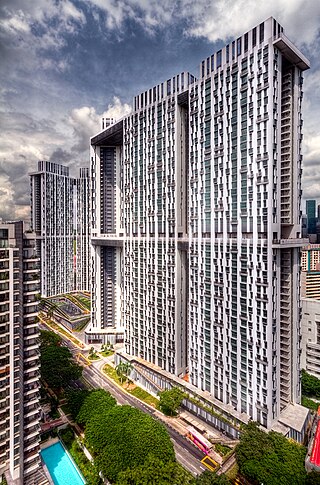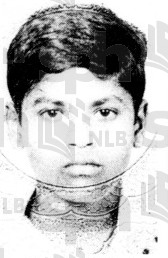Related Research Articles
Nanyang Sin-Chew Lianhe Zaobao, commonly abbreviated as Lianhe Zaobao, is the largest Singaporean Chinese-language newspaper with a daily circulation of about 136,900 as of 2021. Published by SPH Media, it was formed on 16 March 1983 as a result of a merger between Nanyang Siang Pau and Sin Chew Jit Poh, two of Singapore's oldest Chinese newspapers.

Punggol, old name as Ponggol, is a planning area and new town situated on the Tanjong Punggol peninsula in the North-East Region of Singapore. The town directly borders Sengkang to the south and shares riverine boundaries with the planning area of Seletar to the west and Pasir Ris to the east. Bounding the town to the north and north-east is the Straits of Johor, with Coney Island included as a part of the Punggol planning area.

Jurong West is a planning area and residential town located in the West Region of Singapore. Jurong West shares boundaries with Tengah in the north, Jurong East in the east, Boon Lay and Pioneer in the south, and Western Water Catchment in the west.

Ya Kun Kaya Toast, often colloquially known just as Ya Kun, is a Singaporean chain of mass-market, retro-ambience cafés selling toast products, soft-boiled eggs and coffee. Founded by Loi Ah Koon in 1944, Ya Kun remained a small family-run stall for decades, but has expanded rapidly since Loi's youngest son headed the business in 1999. The chain has over fifty outlets, mostly franchised, across 14 countries, and is a Singaporean cultural icon, known for its traditional brand identity and conservative, people-centric corporate culture.
Kelvin Tan Wei Lian is a Singaporean former Mandopop singer who earned a living as a busker before he won the first edition of Project SuperStar in 2005. He has released three albums, All I Want Is... (2006), i-Weilian (2007) and Moving Notes...Kelvin Tan (2009). He also had a solo concert at the Singapore Expo, lead a choir at the opening ceremony at the 2008 Summer Paralympics and singing Singapore's 2009 National Day Parade's theme song.

Pasir Ris Park is a beach park located in the eastern part of Singapore. It covers an area of 70 hectares, and was partially built on reclaimed land. Initially planned in the late 1970s to serve people living in the vicinity, the park was designed with the help of two Japanese landscape specialists. Construction began on the park in September 1984, and the park was opened in phases from August 1986 to 1991. The park was further expanded in 2007, with the addition of new areas such as a herb garden.

The Eye 2 is a 2004 Hong Kong supernatural horror film directed and edited by Danny and Oxide Pang. It is a standalone sequel to The Eye (2002). Produced by Mediacorp Raintree Pictures and Applause, the film was released in Hong Kong on 8 March 2004.
Nanyang Siang Pau was a newspaper in Singapore that was founded by philanthropist-entrepreneur Tan Kah Kee on 6 September 1923. It had a circulation across the Straits Settlement.

The Pinnacle@Duxton is a 50-storey residential development in Singapore's city center, next to the business district. All seven connected towers are collectively the world's tallest public residential buildings, and featuring the two longest sky gardens ever built on skyscrapers, at 500m each.

Tengah is a planning area and future HDB town located within the West Region of Singapore. It is bound by Choa Chu Kang to the northeast, Jurong East and Jurong West to the south, Bukit Batok to the east and the Western Water Catchment to its west and north.

Lianhe Wanbao was a Singapore Chinese afternoon newspaper published daily by SPH Media from 16 March 1983 after the merger between Nanyang Siang Pau and Sin Chew Jit Poh.
Hong Kah is a residential precinct in Jurong West, Singapore. It is bounded by the PIE, Corporation Road, Jurong Canal Drive, Jurong East Avenue 1 and Jurong Town Hall Road. It is named after the former 'Hong Kah Village'.
Haunted Changi, is a 2010 Singaporean found footage horror film directed by Andrew Lau. The film gained attention online prior to its release due to online marketing.
My Dog Dou Dou, is a 2012 Singaporean drama comedy film directed by Ng Say Yong.
One More Chance, is a 2005 Singaporean comedy drama film directed by Jack Neo, Michael Woo and Nan Sing Toh.
On 13 March 1997, at one of the HDB flats in King George's Avenue, Kallang, 53-year-old Sivapackiam Veerappan Rengasamy was discovered dead in her bedroom by her son. Sivapackiam was found to have been stabbed three times in the neck and she died from the wounds. During police investigations, Sivapackiam's tenant Gerardine Andrew, a 36-year-old prostitute, told police that on the day of the murder, she returned to the flat and saw three people attacking her landlady and robbing her, and they threatened her to leave after briefly holding her hostage.
Benjamin Heng is a Singaporean actor, known for starring in the romantic action film Eating Air, the comedy film Lelio Popo, and in the horror comedy film Zombiepura, as well as in several television series, such as Anything Goes, Durian King and Money No Problem!.

On 14 December 1990, at Marsiling, Singapore, during a gang-related incident, a 20-year-old bystander and Malaysian citizen Sivapragasam a/l Subramaniam was struck on the head with an axe and he died as a result of the head injuries. It was revealed that the infamous gang Ang Soon Tong had entered the territory of their rival gang Gi Leng Hor, which happened to be in the same area where Sivapragasam was killed and had the intent to settle scores with the rival gang relating to prior conflicts. Sivapragasam was mistook for a rival gang member and therefore attacked; five other bystanders were also injured. A total of 14 suspects were arrested, and 13 of them were jailed for rioting and causing grievous hurt. The 14th and final suspect, Sagar Suppiah Retnam, who was the headman of Ang Soon Tong, was found guilty of murdering Sivapragasam and sentenced to death on 31 May 1994. Sagar's appeal was dismissed, and he was hanged on 7 July 1995.

On 27 July 1984, 74-year-old Packiria Pillai Krishnasamy was murdered inside his flat at Tah Ching Road, Jurong. The police managed to arrest two suspects, Ramachandran Suppiah and Krishnan Varadan, who were both allegedly responsible for causing Packiria's death during a robbery bid. In May 1987, Ramachandran and Krishnan were both sentenced to hang for murdering Packiria. Although the duo lost their first appeal against the trial verdict, Ramachandran was acquitted after his second appeal, due to insufficient evidence proving that Ramachandran had participated in the crime, and Krishnan however, remained on death row after failing to challenge his conviction a second time. Krishnan was hanged on 15 April 1994 after spending seven years on death row, and he was reportedly the longest-serving death row prisoner in Singapore at the time of his execution.
References
- Adeline Chia (16 September 2007). "'Monkey' tree draws crowds: Tree experts say 'monkey' figures are formed by callusing but devotees think otherwise" (PDF). The Sunday Times . p. L4. Archived from the original (PDF) on 21 April 2008. Retrieved 30 July 2009. archived at "Print Media Highlights". Dpt of Biological Sciences: National University of Singapore. Archived from the original on 13 June 2007.
- Liu Liyi (17 September 2007). "Jurong West 'Monkey tree' drives new fad (in Mandarin)". Lianhe Zaobao . p. 7.